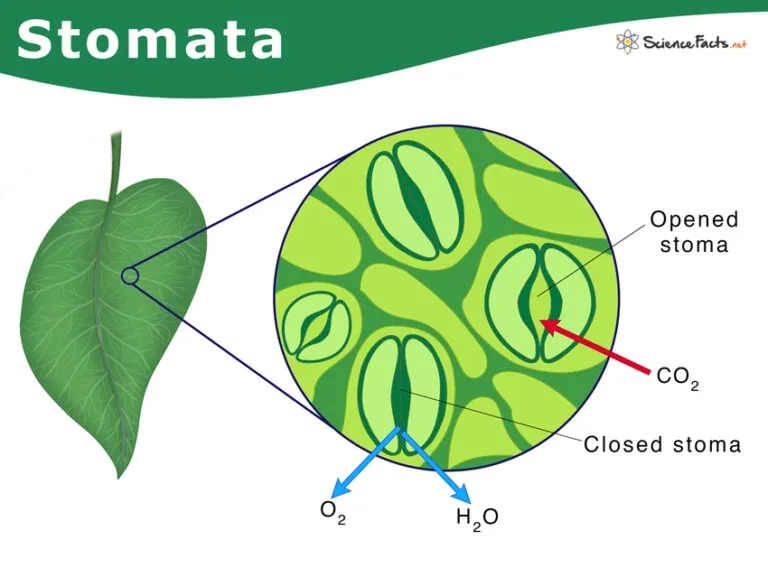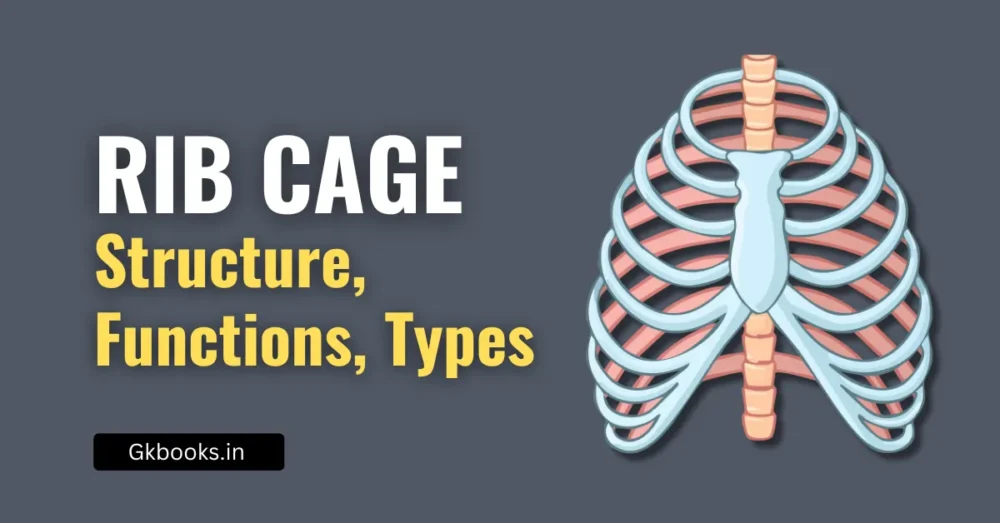Stomata are tiny openings on the surfaces of leaves and stems that play a crucial role in plant physiology. These small pores might seem insignificant, but they are vital for the survival and health of plants. So, what exactly are stomata, and why are they so important?
What Are Stomata?
Stomata are microscopic pores found primarily on the underside of leaves, although they can also be present on stems and other plant parts. Each stoma (singular for stomata) is surrounded by a pair of specialized cells known as guard cells.

Importance of Stomata in Plants
Stomata the tiny openings are essential for several physiological processes in plants, including gas exchange, transpiration, and photosynthesis. They act as gatekeepers, controlling the movement of gases in and out of the plant.
They serve two critical functions:
- Gas Exchange: Just like we breathe, plants also need to exchange gases. Stomata allow carbon dioxide (CO₂) to enter the plant, which is essential for photosynthesis. During photosynthesis, plants use CO₂ and sunlight to create food (sugar) and release oxygen (O₂) as a byproduct. Stomata play a key role in this process by letting in CO₂ and releasing O₂.
- Water Regulation: Stomata also control water movement through a process called transpiration. Transpiration involves water absorption by the plant, its distribution within the plant, and its eventual release into the atmosphere. Stomata help create a water potential within the plant, allowing water to be absorbed by the roots and transported throughout the plant.
In summary, stomata are like tiny gatekeepers for plants. They regulate gas exchange and water balance, ensuring optimal conditions for growth.
✅ Read More: Structure, Components, and Functions of Cell: A Complete Overview
Structure of Stomata
- Stomata are tiny pores found on the epidermis (outer layer) of leaves and young stems.
- Each stoma consists of a pair of guard cells that surround it.
- The cell wall surrounding the pore is tough and flexible.
- Guard cells play a crucial role in regulating stomatal opening and closing.
- When guard cells are turgid (filled with water), the stomata enlarge, allowing gas exchange.
- Stomata are generally more numerous on the underside of leaves.
- They facilitate the exchange of gases between the outside air and the branched system of interconnecting air canals within the leaf.

Components of Stomata
- Stomata consist of the pore (stoma) and two guard cells. The guard cells control the opening and closing of the pore.
- Each stoma consists of a kidney-shaped epidermal cell housing a central opening called a pore.
- Surrounding the stomata are a pair of specialized parenchymal cells called guard cells.
- Guard cells play a crucial role in controlling the size of the stomatal opening, thus preventing excessive water loss from the plant.
✅ Read More: Modes of Nutrition in Living Organisms with Chart and Tables
Guard Cells and Their Function
Guard cells are kidney-shaped in dicots and dumbbell-shaped in monocots. These cells swell or shrink in response to environmental signals, thereby opening or closing the stoma.
Definition
Guard cells are specialized plant cells found in the epidermis of leaves, stems, and other organs. They play a crucial role in controlling gas exchange by opening and closing the stomata (tiny pores) on the leaf surface.
Structure
- Each guard cell surrounds a stoma, forming a pair.
- They resemble bean-shaped cells.
- The guard cells have a relatively thick cuticle on the pore side and a thinner one on the opposite side.
Function
- Transpiration Regulation: Guard cells regulate the rate of transpiration (water loss) by opening or closing the stomata.
- Light Sensitivity: Light serves as the primary trigger for stomatal opening or closing.
- Phototropins: Guard cells contain phototropin proteins, which respond to blue light. These proteins play a role in various plant responses, including stomatal opening.
Types of Stomata
There are several types of stomata, including anomocytic, anisocytic, paracytic, and diacytic, each classified based on the arrangement of surrounding subsidiary cells.
- Anomocytic Stomata: Surrounded by epidermal cells with a fixed shape and size.
- Anisocytic Stomata: Surrounded by three subsidiary cells of unequal sizes.
- Diacytic Stomata: Surrounded by a pair of perpendicular subsidiary cells.
- Paracytic Stomata: Continuously surrounded by two parallel subsidiaries.
- Gramineous Stomata: Possess two dumbbell-shaped guard cells with parallel subsidiaries.
Stomatal Distribution in Plants
Stomatal distribution can vary. Some plants have stomata only on the lower surface of their leaves, while others have them on both surfaces.
Monocot Plants
- Monocots (such as grasses and lilies) have stomata on both the upper and lower epidermis of their leaves.
- The guard cells surrounding these stomata are dumbbell-shaped.
- This equal distribution of stomata on both surfaces is known as amphistomatic distribution.
- Monocot leaves often adjust their shape (rolling) to reduce water loss under excess sunlight.
✅ Read More: Types of Pigment in Plants with examples: Complete Details
Dicot Plants
- Dicots (like roses and oak trees) primarily have stomata on the lower epidermis of their leaves.
- The guard cells around these stomata are bean-shaped.
- This distribution, occurring only on the lower surface, is called hypostomatic distribution.
- Some dicots may also have stomata on the upper epidermis, but adaptations (like trichomes) help minimize water loss from there.
Function of Stomata
The key functions of stomata are quite well! Let’s break it down further:
Gas Exchange
- Stomata enable the exchange of gases (oxygen and carbon dioxide) between the plant and the atmosphere.
- During photosynthesis, plants take in carbon dioxide (CO₂) through stomata. They use this CO₂, along with sunlight, to produce glucose (a form of sugar) and release oxygen (O₂) as a byproduct.
Regulation of Water Loss (Transpiration)
- Stomata play a critical role in transpiration, which is the loss of water vapor from the plant.
- When stomata open, water vapor escapes from the leaves into the air. This process helps maintain water balance within the plant.
Photosynthesis and Transpiration
- Stomata are essential for both photosynthesis and transpiration.
- By controlling stomatal opening and closing, plants can balance their need for gas exchange while minimizing excessive water loss.
Mechanism of Stomatal Movement
The opening and closing of stomata are complex processes influenced by various factors.
Stomatal Opening
- Guard cells, which surround each stoma, play a crucial role.
- When turgor pressure increases in guard cells (due to water intake), they swell.
- The inner walls near the stoma are radially thickened but can’t expand fully.
- As a result, the guard cells curve, opening the stoma for gas exchange.
Stomatal Closure
- Water stress or other factors decrease guard cell turgor pressure.
- Guard cells lose water and become flaccid, causing stomatal closure.
- This balance ensures efficient gas exchange while minimizing water loss.
Role of Potassium Ions
Potassium ions play a crucial role in regulating the opening and closing of stomata in plants. Let’s uncover the details:
Stomatal Opening
- Stomata are tiny pores on the surface of leaves that allow for gas exchange (carbon dioxide uptake and oxygen release) and water vapor loss.
- When light triggers stomatal opening (usually during photosynthesis), potassium ions (K⁺) come into play.
- The guard cells surrounding each stoma have radially thickened walls. When turgor pressure increases in these guard cells (due to water uptake), they swell.
- However, the thickened inner walls near the stoma cannot expand, so they curve outward, causing the stoma to open.
- In summary, K⁺ influx into guard cells increases turgor pressure, leading to stomatal opening.
Stomatal Closure
- Water stress, high temperatures, and elevated carbon dioxide levels signal stomatal closure.
- Abscisic acid (ABA), a plant hormone, plays a key role in this process.
- ABA reduces K⁺ uptake by guard cells, decreasing turgor pressure and causing the stoma to close.
- By regulating the stomatal aperture, plants balance gas exchange (essential for photosynthesis) with water conservation.
In summary, potassium helps maintain stomatal function, ensuring efficient photosynthesis while minimizing water loss.
Environmental Factors Influencing Stomatal Movement
Light, carbon dioxide concentration, and humidity are among the environmental factors that influence stomatal movement.
Stomatal movement, crucial for gas exchange and water regulation in plants, is influenced by various environmental factors. Let’s explore them:
Light
- Light plays a significant role in stomatal movement.
- Blue and red light are effective in both photosynthesis and stomatal opening.
- Blue light, in particular, promotes the breakdown of starch into PEP molecules, leading to malic acid production and K⁺ movement, which facilitates stomatal opening.
Water Content of Epidermal Cells
- Guard cells, responsible for stomatal movement, derive water from adjacent epidermal cells.
- Water availability in epidermal cells affects guard cell turgor pressure and, consequently, stomatal opening or closure.
Temperature
- Higher temperatures cause stomata to open.
- Temperature affects guard cell wall permeability and osmotic processes, influencing stomatal movement.
Mineral Elements
- Deficiencies in nitrogen, phosphorus, and potassium impact stomatal behavior.
- These elements play a role in regulating stomatal aperture.
Remember that stomata open during the day (photoactive stomata) and close at night.
Stomatal Density and Distribution
Stomatal density refers to the number of stomata per unit area of a leaf. Here are some key points:
Stomatal Density Range
- Stomatal density varies widely among different plant species.
- It can range from approximately 1,400 to 40,000 stomata per square centimeter of leaf surface.
- Monocots and dicots may exhibit different stomatal densities, and variations can occur between the upper and lower leaf surfaces.
Importance
- Stomata play a crucial role in gas exchange.
- They allow carbon dioxide (CO₂) to enter the leaf for photosynthesis while controlling water loss through transpiration.
- The number and distribution of stomata influence the efficiency of these processes.
Physiological and Morphological Factors
- Stomatal control involves both physiological regulation (by guard cells) and morphological adjustments (number and size of stomata).
- The conductance of CO₂ and water vapor depends on stomatal morphology (size, spacing, and arrangement) and physiology (aperture regulation) in response to environmental conditions.
- Understanding stomatal density helps us appreciate plant evolution, adapt to climate change, and enhance crop productivity.
Factors Affecting Stomatal Density
Stomatal density, which refers to the number of stomata per unit area of a leaf, plays a crucial role in determining the rate of gas exchange and water loss from a leaf. Stomatal density and distribution are influenced by several factors. Light intensity, carbon dioxide levels, and water availability can all affect stomatal density. Here are some key factors influencing stomatal density:
Light Intensity
- Stomatal density can increase with higher light intensity.
- More light availability often leads to greater stomatal development.
Carbon Dioxide (CO₂) Concentration
- Some species exhibit higher stomatal density at lower CO₂ concentrations.
- Stomata adjust their initiation based on CO₂ responsiveness.
Altitude
- Species at higher altitudes may have higher stomatal density.
Temperature
- Stomatal density can be influenced by temperature.
- Generally, it increases with rising temperatures.
Humidity and Drought
- Environmental conditions affect stomatal development.
- Humidity and drought play a role in stomatal density regulation.
Remember that stomatal density varies between monocots and dicots, among different plant species, and even between the upper and lower leaf surfaces of a plant.
Adaptation to Different Environments
Plants adapt their stomatal density to different environmental conditions to optimize water use and gas exchange.
Role of Stomata in Plant Physiology
Stomata play a vital role in plant development by regulating gas exchange with the atmosphere and controlling transpiration. Let’s explore their functions:
Gas Exchange
- Stomata act as entryways for carbon dioxide (CO₂) during photosynthesis.
- They allow CO₂ to enter the leaf, which serves as fuel for photosynthesis.
- As a byproduct, oxygen (O₂) is released into the atmosphere through stomata.
Transpiration Regulation
- Stomata control water movement by opening and closing.
- When conditions are favorable, stomata open wide, facilitating gaseous exchange.
- Guard cells, surrounding stomatal pores, regulate pore size by expanding or contracting.
- Water rushes into guard cells through osmosis, affecting the stomatal aperture.
- Transpiration through stomata creates a water potential within the plant, favoring passive water absorption in the roots.
- This absorbed water is then transported throughout the plant via the xylem.
Adaptability
- Stomata can change shape and size based on environmental signals.
- Factors like light intensity, CO₂ concentration, temperature, and humidity influence stomatal behavior.
- Optimum conditions ensure efficient photosynthesis while minimizing water loss.
In summary, stomata are essential for gas exchange, nutrient distribution, and hormonal signaling within plants. They contribute to growth and overall plant health.
Impact on Plant Growth
Efficient stomatal function is crucial for optimal plant growth and development. Let’s explore how:
Photosynthesis
- Stomata allow carbon dioxide (CO₂) to enter the leaf, a crucial step in photosynthesis.
- During photosynthesis, plants convert CO₂ and sunlight into glucose (energy) and oxygen.
- Efficient stomatal function ensures optimal CO₂ uptake, promoting healthy growth.
Transpiration and Water Balance
- Stomata regulate water loss through transpiration.
- By opening and closing, they control the rate of water vapor escaping from leaves.
- Proper water balance is essential for nutrient transport, cell expansion, and overall plant health.
Nutrient Uptake
- Stomatal movement affects nutrient absorption.
- As water evaporates through stomata, it creates a negative pressure that draws water and dissolved nutrients from the soil into the roots.
- Nutrients are then transported upward through the xylem to support growth.
Temperature Regulation
- Stomatal closure during extreme heat reduces water loss.
- This helps prevent wilting and maintains cellular turgor pressure.
- Balanced stomatal behavior ensures temperature regulation and prevents stress.
Adaptability to Environmental Changes
- Stomata respond to light, humidity, and other environmental cues.
- They adjust the aperture to optimize gas exchange while minimizing water loss.
- Adaptability ensures survival and growth under varying conditions.
In summary, healthy stomatal function directly influences plant growth, development, and overall fitness. If you have more questions or need further details, feel free to ask!
Stomata and Water Use Efficiency
Let’s explore the relationship between stomata and water use efficiency:
Stomatal Control
- Stomata regulate water loss through transpiration.
- When stomata open, water vapor escapes from the leaf surface.
- However, this process is essential for gas exchange (CO₂ uptake and O₂ release) during photosynthesis.
Water Use Efficiency (WUE)
- WUE measures how efficiently a plant uses water to produce biomass (growth).
- High WUE means that a plant achieves good growth while minimizing water loss.
- Stomatal behavior directly affects WUE.
Trade-Off
- There’s a trade-off between CO₂ uptake and water loss.
- When stomata open wider for better CO₂ uptake, more water escapes.
- Conversely, closing stomata conserves water but limits CO₂ availability.
Adaptations for WUE
Some plants have adaptations to enhance WUE:
- C₄ Plants: They concentrate CO₂ around Rubisco, reducing stomatal opening.
- CAM Plants: They open stomata at night (when it’s cooler) to minimize water loss.
- Xerophytes: These desert-adapted plants have reduced stomatal density and thick cuticles.
Environmental Factors
- Light, humidity, temperature, and soil moisture influence stomatal behavior.
- Optimal conditions balance growth and water conservation.
Stomata play a crucial role in both photosynthesis and water management. Plants have evolved diverse strategies to optimize WUE based on their habitats.
Stomata in Monocots vs. Dicots
Monocots typically have stomata on both leaf surfaces, while dicots usually have them only on the lower surface.
| Aspect | Monocots | Dicots |
|---|---|---|
| Stomata Distribution | Amphistomatic (both surfaces) | Hypostomatic (lower surface) |
| Guard Cells | Dumbbell-shaped | Bean-shaped |
| Transpiration | Higher transpiration rates | Water conservation due to location |
Stomata in Xerophytes and Hydrophytes
Xerophytes (dry environment plants) and hydrophytes (water plants) have specialized stomatal adaptations for their respective environments.
Let’s explore the adaptations of stomata in xerophytes (plants adapted to dry conditions) and hydrophytes (plants adapted to freshwater environments):
Xerophytes
- Stomata Location: Xerophytes typically have stomata mainly on the upper epidermis of leaves.
- Gas Exchange: Stomata are usually open all the time, allowing efficient gas exchange with the air.
Adaptations
- Reduced root system: Xerophytes require only small roots since they can extract nutrients from the surrounding soil through their tissues.
- Thin waterproof waxy cuticle: The cuticle is thin because water loss prevention is less critical.
- Reduced veins in leaves: Xylem is minimized as there’s no need for extensive water transport.
Hydrophytes
- Stomata Location: Hydrophytes lack stomata on their submerged parts.
- Floating Leaves: Their leaves are thin, flat, and buoyant, with large air spaces to keep them close to the water surface where there’s more light for photosynthesis.
Adaptations
- Thin waterproof cuticle: Less need to prevent water loss due to the aquatic environment.
- Stomata on upper leaf surface: Allows gas exchange with air rather than water.
- Reduced root system: Extracts nutrients from the surrounding water.
- Reduced veins: Minimal xylem for water transport.
Remember that these adaptations help xerophytes and hydrophytes thrive in their respective habitats.
Conclusion
Stomata are tiny but mighty players in the world of plants. Their role in gas exchange, water regulation, and overall plant health cannot be overstated. As we continue to explore and understand these small structures, we can harness their potential for agricultural advancement and environmental conservation.
FAQs About Stomata
Stomata are tiny openings on plant surfaces that allow for gas exchange and transpiration.
Stomata facilitate the intake of carbon dioxide, which is necessary for photosynthesis.
Stomata typically close at night to conserve water, as photosynthesis does not occur without sunlight.
Higher stomatal density can enhance gas exchange and photosynthesis, leading to better growth, but it can also increase water loss.
Stomata are microscopic and cannot be seen with the naked eye. They require a microscope for observation.
More Biology Topics:







